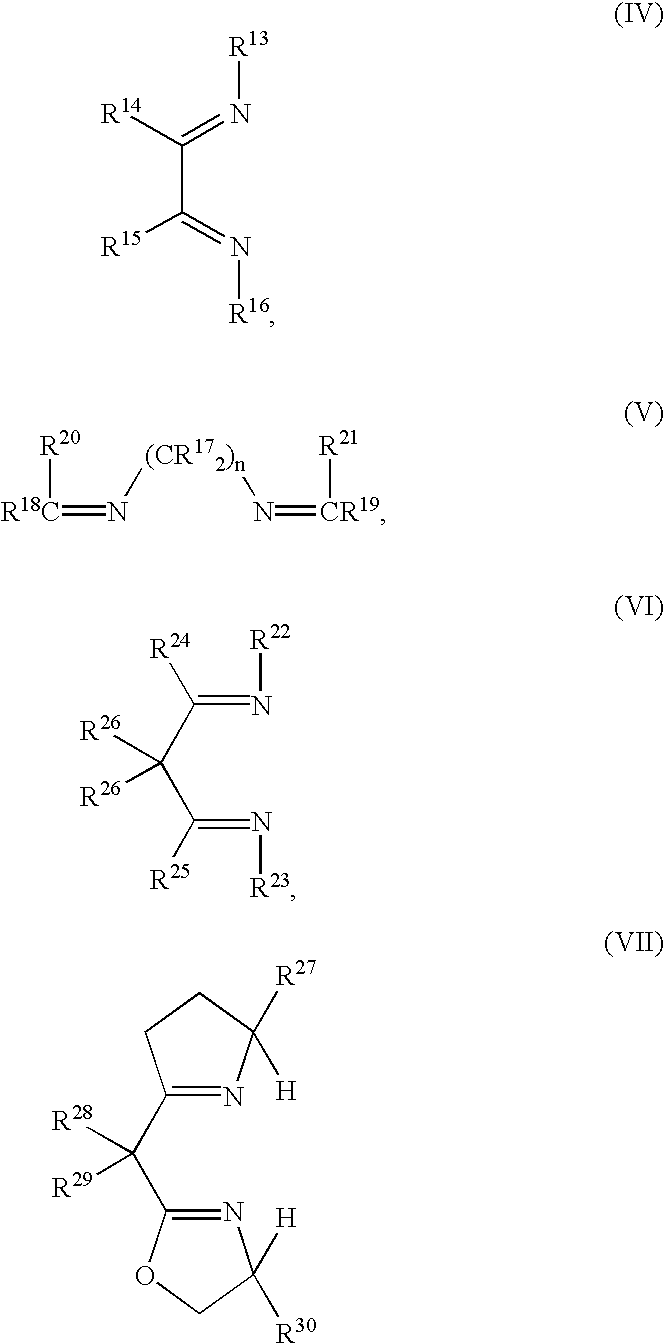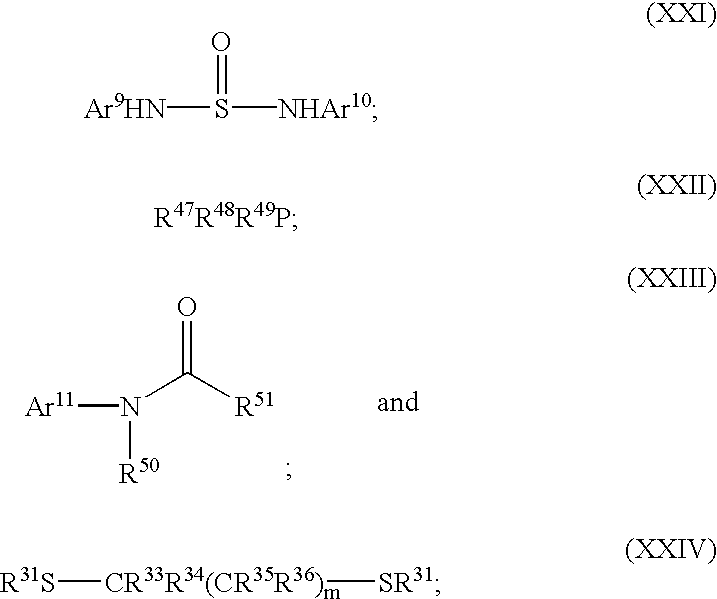Polymerization of olefins
a technology of olefins and polymerization methods, applied in the field of polyolefins, can solve the problems of reducing the efficiency of polymerization, unable to proceed with polymerization, and unable to achieve the effect of polymerization,
- Summary
- Abstract
- Description
- Claims
- Application Information
AI Technical Summary
Problems solved by technology
Method used
Image
Examples
example 2
Ethylene Copolymer of 7-Octenyltrichlorosilane
The compound PdCH.sub.2 CH.sub.2 CH.sub.2 C(O)OCH.sub.3 [(2,6-i-PrPh).sub.2 DABMe.sub.2 ]SbF.sub.6 (0.0848 g, 0.1 mmol) and CH.sub.2.dbd.CH.sub.2 (CH.sub.2).sub.6 SiCl.sub.3 (2.5 g, 0.010 mol) were dissolved in 40 mL CH.sub.2 Cl.sub.2. The solution was placed under 1 atm of ethylene under stirring for 48.5 h at RT. Solvent was then evaporated. In a dry box, the residue was dissolved in 20 mL heptane and then 20 mL HC(OMe).sub.3 was added. The mixture was refluxed for 1 h. Methanol (ca. 60 mL ) was added to the room temperature solution. The upper layer was decanted. The residue was dissolved in 20 mL of pentane, followed by addition of 60 mL methanol. The oil was isolated and vacuum dried. Three g of a viscous oil was obtained. Based on .sup.1 H NMR, the silane incorporation (in terms of --Si(OCH.sub.3).sub.3) was 4.35 mole %. The polymer was highly branched based on .sup.1 H NMR (80Me / 1000CH.sub.2). The copolymer exhibited a Tg of -69.d...
example 3
The compound PdCH.sub.2 CH.sub.2 CH.sub.2 C(O)OCH.sub.3 [(2,6-i-PrPh).sub.2 DABMe.sub.2 ]SbF.sub.6 (0.0848 g, 0.1 mmol) and CH.sub.2.dbd.CH.sub.2 (CH.sub.2).sub.6 SiCl.sub.3 (2.5 g, 0.010 mol) were dissolved in 40 mL CH.sub.2 Cl.sub.2. The solution was placed under 1 atm of ethylene under stirring for 60 h at RT. Solvent was then evaporated. In a dry box, the residue was dissolved in 10 mL of methylene chloride and then 60 mL of slightly wet acetone was added. The upper layer was decanted. To the residue was added 15 mL of methylene chloride. Some polymer couldn't be redissolved at this point. Another 60 mL of acetone was added. The product was isolated and vacuum dried. An elastic white solid was obtained.
This Example demonstrated that the above --SiCl.sub.3 containing ethylene copolymer can be easily crosslinked by trace amounts of water.
example 4
Synthesis of Silane-Containing Ethylene Copolymer
A 5.1-mg (0.0082-mmol) sample of [(2,6-i-PrPh).sub.2 DABMe.sub.2 ]NiBr.sub.2 was placed in a Parr.RTM. 600-mL stirred autoclave and 200 mL of dry hexane (dried and stored over molecular sieves and kept under nitrogen) was added. The solvent was saturated with ethylene and was heated to 60.degree. C., and a solution of 1.0 g (4.1 mmol) of 7-octenyltrichlorosilane in 5 mL dry toluene was injected into the autoclave through a head port. Then 1.0 mL of modified methylalumoxane (Akzo MMAO-3A; nominal 1.97M in toluene; contains about 30% isobutyl groups) was injected into the autoclave. The autoclave was pressured to 690 kPa with ethylene and was stirred for 30 min at 60.degree. C. The ethylene was vented and 9 mL anhydrous n-propanol (distilled from metallic sodium) was injected into the autoclave to stop polymerization and to convert the trichlorosilane groups to tri-n-propoxysilane groups in situ. The autoclave contained a solution of po...
PUM
| Property | Measurement | Unit |
|---|---|---|
| Angle | aaaaa | aaaaa |
| Temperature | aaaaa | aaaaa |
| Covalent bond | aaaaa | aaaaa |
Abstract
Description
Claims
Application Information
 Login to View More
Login to View More - R&D
- Intellectual Property
- Life Sciences
- Materials
- Tech Scout
- Unparalleled Data Quality
- Higher Quality Content
- 60% Fewer Hallucinations
Browse by: Latest US Patents, China's latest patents, Technical Efficacy Thesaurus, Application Domain, Technology Topic, Popular Technical Reports.
© 2025 PatSnap. All rights reserved.Legal|Privacy policy|Modern Slavery Act Transparency Statement|Sitemap|About US| Contact US: help@patsnap.com



